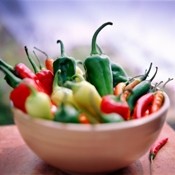In New Mexico, it’s all about the chile. Grown just about everywhere from the Hatch Valley in the south to up near the Colorado border, the state’s profusion of pungent, aromatic chile peppers are what defines New Mexican cuisine and, to some extent, even New Mexican culture as well.
Experiencing the enticing foods and flavors of New Mexico, a combo platter of Native American, Spanish and Anglo influences, is one of the chief delights of meeting in the Land of Enchantment. Along with great dining opportunities, a broad menu of food-related activities is there to fire up the agenda, including salsa-making competitions, “Chile Chat” sessions, chef-led visits to farmers’ markets, and pueblo-style bread baking.
Culinary Heritage
“What really makes New Mexico food stand out is the chile,” says Gwyneth Doland, an Albuquerque-based cookbook author and editor of Fiery Foods magazine. “We [New Mexicans] grow several varieties of it and we eat lots of it. The most famous question in restaurants here is whether you want your chile green or red.”
That question typically refers to the simple sauces made from a puree of red or green chiles served over enchiladas and other traditional dishes. Diners who can’t decide can ask for their plates to be served “Christmas style” with a bit of both.
Although red and green chiles appear to be different varieties, a red chile is simply a green chile that has been allowed to ripen. While green chiles are often roasted to bring out their full flavor, red chiles are usually dried and strung into the colorful ristras that adorn farm stands throughout the state during the fall harvest season.
Mark Ching, executive chef at the Hyatt Regency Tamaya Resort on the Santa Ana Pueblo near Santa Fe, is another local food expert who sings the praises of the New Mexico chile. He frequently presents the resort’s Chile Chat classes, which are seminars focusing on the history and tradition of New Mexico’s favorite crop.
“People usually don’t know that there is a difference between New Mexican cuisine and others in the Southwest, but there really are some nuances that set New Mexico apart,” he says. “The chile is the defining factor—it’s not used the same way anywhere else. New Mexico chiles are unique to New Mexico—they are not the same as the poblano used in Arizona or the Anaheim grown in California.”
In particular, he lauds the local tradition of roasting newly harvested green chiles in gas-fired roasters or over grills.
“During harvest time you will see people roasting chiles everywhere. The aroma in the air is wonderful and so is the flavor,” he says.
Ching also cites ingredients such as black beans, including heirloom varieties that are a specialty crop at many of the state’s 19 Native American pueblos, and blue corn, which, while not unique to New Mexico, plays a starring role in many local dishes.
“Blue cornmeal is different from other cornmeal as night is from day,” he says. “It’s sweet but also nutty and the texture is a finer grind. Plus it’s a really cool color. We use it to form tortillas and tamales as well as in things like tempura batter for calamari.”
Guests at Tamaya can observe and participate in Native American culinary practices, including working beside pueblo women baking bread in traditional hornos, which are outdoor ovens.
“We don’t have the bread recipe—it’s from a 900-year-old tradition,” Ching says. “The pueblo ladies make the dough and shape the loaves each day.”
According to Doland, the longevity of many of New Mexico’s culinary traditions is also what makes local cuisine unique.
“New Mexico food is not trendy and has changed little since the Spaniards came up here from Mexico 500 years ago,” she says. “There’s a limited range of ingredients and the enchiladas we make today are not much different from those our grandmothers made. The settlements here were isolated for centuries and things stayed the same. That’s why our foods are different even from Arizona and Texas.”
Back to School
For those who want to fully appreciate New Mexico’s culinary legacy, a good place to start is the Santa Fe School of Cooking, which offers a variety of team-building challenges and classes that can be tailored for groups.
“We focus only on local foods, as our mission is to support New Mexico farmers, winemakers and artisans,” says manager and co-owner Nicole Ammerman. “One of our most popular courses for groups is the Culinary History of the Rio Grande Valley, which is not so much a class as an experience of our history. We look at what the indigenous people were eating here 5,000 years ago and go up through contemporary Santa Fe cuisine.”
Another popular option is a chef-led walk through Santa Fe, where participants stop in at local restaurants to meet with the chefs and sample their specialty dishes. Among team-building challenges are the Salsa Making Contest and Farm, Fresh and Local, where participants are given a box of fresh produce and must make a spontaneous decision with the chef about what to prepare.
In Albuquerque, the Jane Butel Cooking School, owned by the author of Real Women Eat Chiles and other books on New Mexican food, is another source for culinary classes and team building. Teams can gather for participatory cooking sessions such as Fajita Party and New Mexican Favorites or for demonstrations where chefs prepare such specialties as green chile chicken enchiladas.
Dining Around
While good restaurants serving both traditional and contemporary Southwestern dishes abound in New Mexico, several stand out as places where groups can really experience the state’s culinary heritage.
Among them is the newly expanded Pueblo Harvest Cafe at the Indian Pueblo Cultural Center in Albuquerque, which features a main dining area with a two-story flagstone fireplace, a covered patio and a private dining room with views of the Sandia Mountains. Specialties include pueblo bread baked in two exterior hornos as well as dishes such as blue corn enchiladas, buffalo tenderloin and New Mexico lamb. Up to 400 people can enjoy catered receptions at the center, which has also expanded its galleries devoted to pueblo history and art.
At Albuquerque’s National Hispanic Center, La Fonda del Bosque Restaurant offers a chile-infused menu with dishes such as posole, a stew of pork and hominy, and stuffed sopapillas, puffy fried bread filled with beans, meat and cheese. The restaurant also provides catering for the facility, which offers exhibits on Hispanic culture along with a variety of indoor and outdoor event spaces.
One of the state’s most historic dining venues is La Posta de Mesilla, a national historic landmark in Mesilla just outside Las Cruces that dates from the 1840s as a stagecoach stop and hotel. Its menu is composed of recipes handed down by generations of the families who have operated the restaurant, many of them making liberal use of the chiles grown in the nearby Hatch Valley. Its warren of adobe buildings contains several private dining rooms as well as the Hot Hot Little Chile Shop, which includes a Wall of Flame displaying over 60 hot sauces.
On the Farm
New Mexico’s culinary heritage can also be appreciated right at the source—by arranging a farm visit where chiles and other local crops are raised. In Las Cruces, located in the heart of southern New Mexico’s chile country, the CVB has even developed a suggested “Chile Chile Chile!” itinerary that includes visits to the Biad Chile Co., one of the state’s largest farms, and the Chile Pepper Institute with its demonstration garden on the campus of New Mexico State University.
The Las Cruces itinerary also suggests visiting New Mexico Farm and Ranch, a 47-acre interactive museum devoted to the 3,000-year history of farming in New Mexico that includes a variety of indoor and outdoor event spaces. The museum, which offers salsa making classes and other workshops, features a livestock corral, exhibits on New Mexico agriculture and orchards of pecans, pistachios and apples.
For groups based in Santa Fe or Albuquerque, tours of organic farms devoted to such crops as squash, beans, chiles, and herbs can be easily arranged, according to Arlene Schiffer, owner of Passport New Mexico, a local DMC.
“We work with the Santa Fe School of Cooking to arrange a wide variety of farm tours,” she says, adding that a particular favorite among groups is the Salmon Raspberry Ranch in northern New Mexico’s La Cueva Historic District.
Known for its raspberry crop and products such as raspberry vinegar, Salmon Raspberry Ranch dates from the early 1800s. On the extensive grounds are a Territorial-style main house, grist mill, mission church, store, and picnic areas situated in gardens planted with lavender, roses and willows.
For More Info
Albuquerque CVB 505.842.9918 www.itsatrip.org
Farmington CVB 505.326.7602 www.farmingtonnm.org
Las Cruces CVB 505.541.2444 www.lascrucescvb.org
Roswell COC 505.623.5695 www.roswellnm.org
Ruidoso Valley COC 505.257.7395 www.ruidosonow.com
Santa Fe CVB 505.955.6200 www.santafe.org
Taos County COC and Visitor Bureau 505.758.3873 www.taoschamber.com







